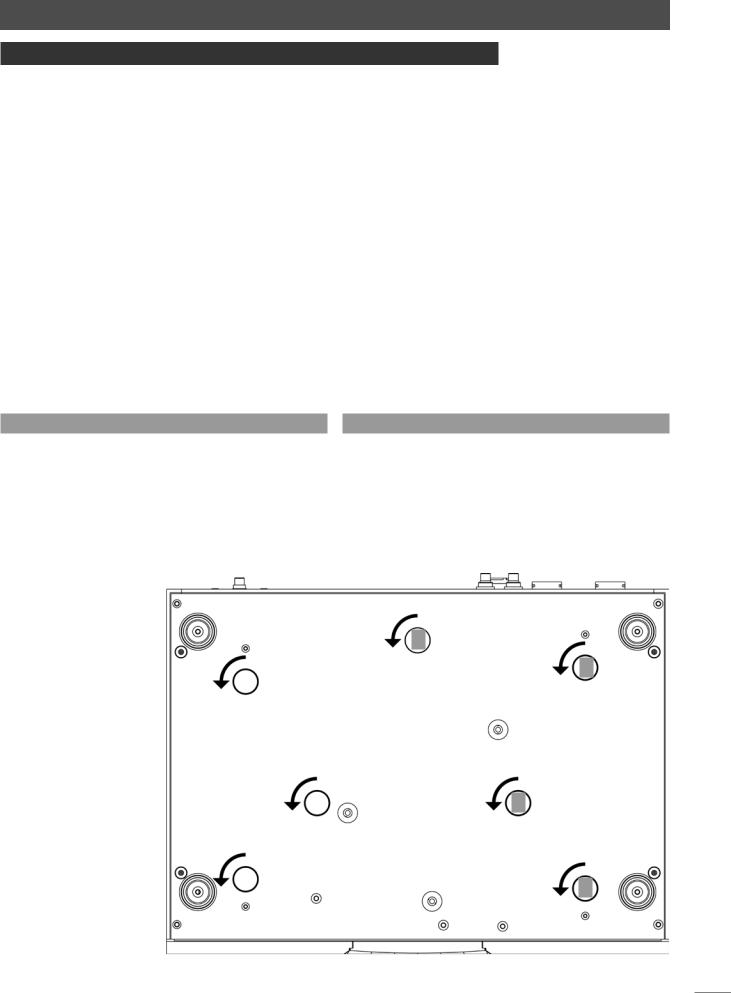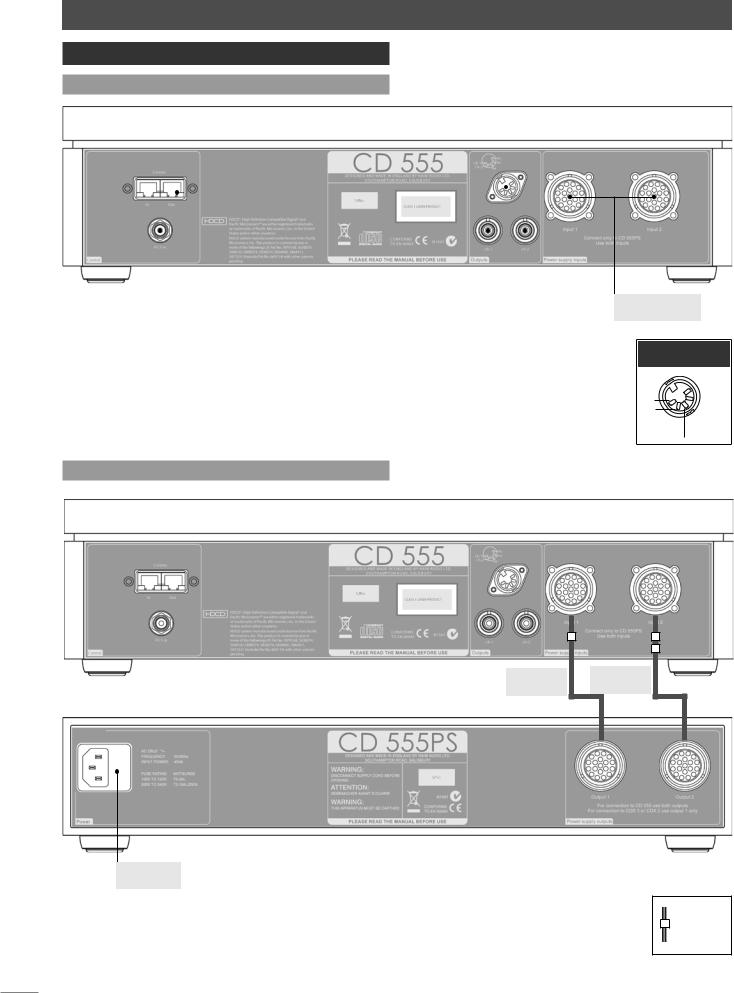Naim Audio CD-5-X Owners manual

o w n e r s m a n u a L C D P L A Y E R S
E N G L I S H D E U T S C H F R A N Ç A I S I T A L I A N 0

SAFETY INSTRUCTIONS
In order to comply with current European safety regulations it is essential that the Naim loudspeaker connectors supplied with amplifiers and loudspeakers are used.
Do not under any circumstances allow anyone to modify your Naim equipment without first checking with the factory, your retailer, or your distributor. Unauthorised modifications will invalidate your guarantee.
Equipment must not be exposed to dripping or splashing and no objects filled with liquid, such as vases, should be placed on the equipment.
For your own safety do not under any circumstances open Naim equipment without first disconnecting it from the mains.
Warning: an apparatus with CLASS I construction shall be connected to a mains socket outlet with a protective earthing connection.
Where the mains plug or an appliance coupler is used as the disconnect device, the disconnect device shall remain readily operable. To disconnect the equipment from the mains remove the mains plug from the mains outlet.
The following label is attached to all mains powered equipment:
w a r n i n g
This apparatus must be earthed
note
This equipment has been tested and found to comply with the relevant EMC and Safety Standards, and, where
applicable, also complies with the limits for a class B digital device, pursuant to Part 15 of the FCC Rules.
These limits are designed to provide reasonable protection against harmful interference in a residential installation. This equipment generates, uses and can radiate radio frequency and, if not installed and used in accordance with the instructions, may cause harmful interference to radio communications. However, there is no guarantee that interference will not occur in a particular installation. If this equipment does cause harmful interference to radio or television reception, which can be determined by turning off and on, the user is encouraged to try to correct the interference by one or more of the following measures:
•Reorient or relocate the receiving antenna.
•Increase the separation between the equipment and the receiver.
•Connect the equipment into an outlet on a circuit different from that to which the receiver is connected.
•Consult your Naim retailer or an experienced radio/TV technician for help.
Contents
Page Section
1 |
1 |
Connections |
12 Mains Power
23 General Installation
34 CD 555 Introduction and Installation
45 CD 555 Connections
56 CD 555 In Use
67 CDS3 Introduction and Installation
78 CDS3 Connections
89 CDS3 In Use
910 CDX2 Introduction and Installation
911 CDX2 Connections
1012 CDX2 In Use
1113 CD5x Introduction and Installation
1114 CD5x Connections
1215 CD5x In Use
1316 CD5i Introduction and Installation
13 |
17 |
CD5i Connections |
1318 CD5i In Use
1419 CD Player Control and Operation
1520 Flash Handset
1621 Narcom 4 Handset
1722 Puck Identification
17 |
23 |
Declarations |

Introduction
Naim Audio products are conceived with performance as the top priority. Careful installation will help ensure that their full potential is achieved. This manual covers the CD 555, CDS3, CDX2, CD5x and CD5i CD players and their associated or upgrade power supplies. It begins with some general installation notes and statutory safety warnings. Product specific information begins in Section 4.
1 Connections
It is important for both safety and performance that the standard cables supplied are not modified.
1.1 Interconnect Cables
If options are available with your equipment and installation, DIN interconnect sockets should be used in preference to RCA Phono sockets. One end of each Naim interconnect cable is marked with a band to establish
its correct orientation. The band denotes the end that connects to the signal source.
Interconnect plugs and sockets should be kept clean and free from corrosion. The easiest way to clean them is to switch off the equipment, pull the plugs out of their sockets, and push them back in again. Contact cleaners and “enhancers” should not be used as the film they deposit may degrade the sound.
1.2 Loudspeaker Cables
Loudspeaker cables are vitally important. They should each be at least 3.5 metres long and of equal length. The recommended maximum is normally 20 metres although longer cables may be viable with some Naim amplifiers.
Some Naim amplifiers are designed only to work with Naim loudspeaker cable and using alternatives may degrade the performance or even damage the amplifier. Other Naim amplifiers can be used with any high quality loudspeaker cable although we recommend that Naim loudspeaker cable is used. Naim loudspeaker cable is directional and should be oriented so that the printed arrow points towards the speakers. The Naim loudspeaker connectors supplied are designed to comply with European safety legislation and must be used.
Contact your local retailer or distributor for further advice on loudspeaker cables and connectors.
2 Mains Power
Where fused plugs are used 13 amp fuses should be fitted. Fuses of a lower rating will fail after a period of use. Do not wire voltage dependent resistors or noise suppressors into mains plugs. They degrade the mains supply and the sound.
2.1 Mains Plug Wiring
In some territories a mains plug may need to be fitted to the supplied mains lead. As the colours of the wires in
the mains lead may not correspond with the coloured markings identifying the terminals in the plug proceed as follows:
The wire coloured GREEN-AND-YELLOW must be connected to the terminal in the plug marked by the letter E or by the safety earth symbol or coloured GREEN or
GREEN and YELLOW.
The wire coloured BLUE must be connected to the terminal in the plug marked with the letter N or coloured BLACK.
The wire coloured BROWN must be connected to the terminal in the plug marked with the letter L or coloured
RED.
2.2 Equipment Fuses
Mains powered Naim Audio equipment is fitted with a mains fuse on the rear panel adjacent to the mains input socket. Replace it if necessary only with the spare fuse supplied or with an identical fuse. Repeated failure of the fuse points to a fault that should be investigated by your retailer or Naim itself.
2.3 Non-rewirable Mains Plugs
If a non-rewirable plug is cut from a mains lead (for whatever purpose) the plug MUST be disposed of in a way to render it totally useless. Considerable shock hazard exists if the cut-off plug is inserted into a mains outlet.
2.4 Mains Circuits and Cables
A hi-fi system usually shares a mains circuit with other household equipment some of which can cause distortion of the mains waveform. This distortion can in turn lead to mechanical hum from mains transformers. Some Naim transformers are large in size, making them relatively sensitive to such distortion, and it may be necessary
to take account of transformer hum when siting your equipment.
Transformer hum is not transmitted through the speakers and has no effect on the performance of the system; however, a separate mains circuit may reduce it. Such a circuit (ideally with a 30 or 45 Amp rating) will also generally improve system performance. Advice on the installation of a separate mains circuit should be sought from a qualified electrician.
Do not substitute alternative mains leads and plugs to those supplied. They are selected to offer the best possible performance.

Introduction
3 General Installation
Naim equipment is designed to offer the finest performance possible avoiding compromise wherever practical. This can lead to circumstances that may be unfamiliar. The notes that follow contain advice specifically related to Naim equipment
as well as more general warnings about the use of domestic audio products. Please read them carefully.
3.1 Siting The Equipment
In order to reduce the risk of hum audible from the loudspeakers, power supplies and power amplifiers should be located a reasonable distance away from other equipment. The maximum separation distance for connected equipment is that allowed by the standard interconnect lead.
Some Naim equipment is extremely heavy. Check the weight of the equipment prior to lifting and if necessary use more than one person so that it can be moved safely. Ensure that your equipment rack or table can easily support the weight and is stable.
Some speakers and stands are intended to be used with floor spikes fitted. Care should be taken when siting and moving them to avoid personal injury or damage to cables and surfaces. Floor protectors are available from your local dealer or distributor to protect non carpeted floors.
3.2 Switching On
Source components and power supplies should be switched on before the power amplifiers. Always switch amplifiers off and wait a minute before connecting or disconnecting any leads. Always use the power switch on the product rather than a mains outlet switch.
A “thump” may be heard from the loudspeakers as power amplifiers are switched on. This is normal, will not cause any loudspeaker damage and does not point to any fault or problem. A mild “pop” may also be heard shortly after equipment is switched off.
3.3 Running In
Naim equipment takes a considerable time to run in before it performs at its best. The duration varies, but under some conditions the sound may continue to improve for over a month. Better and more consistent performance will be achieved if the system is left switched on for long periods. It is worth remembering however that equipment left connected to the mains can be damaged by lightning.
3.4 Radio Interference
In some circumstances, depending on where you live and the earthing arrangements in your home, you may experience radio frequency interference. Controls on broadcasting in some territories allow very high levels of radio frequency radiation and both the choice and exact siting of equipment may be critical. Susceptibility to radio frequency interference is related to the wide internal bandwidth necessary for high sound quality. A radio frequency filter kit is available for some Naim equipment but sound quality will be progressively compromised as more elements of the kit are fitted. In situations of extreme radio interference Naim equipment may be unsuitable.
3.5 Lightning Precautions
Your Naim hi-fi system can be damaged by lightning and should be turned off and disconnected from the mains when there is risk of lightning strike. For complete
protection all mains plugs and any aerial cables should be disconnected when not in use.
3.6 Problems?
Consumer protection varies from country to country. In most territories a retailer must be prepared to take back any equipment he has sold if it cannot be made to work satisfactorily. A problem may be due to a fault in the system or its installation so it is essential to make full use of your dealer’s diagnostic skills. Please contact your local distributor, or Naim Audio directly, if any difficulties cannot be resolved.
Some Naim equipment is made in special versions for different territories and this makes it impracticable to arrange international guarantees. Please establish the local guarantee arrangements with your retailer. Contact Naim Audio directly for help and advice if necessary.
3.7 Service and Updates
It is essential that repairs and updates are only carried out by an authorised Naim retailer or at the factory by Naim itself. Many components are custom made, tested or matched and appropriate replacements are often unobtainable from other sources.
Direct contact to Naim for service or update information should be made initially through Customer Services:
Tel: +44 (0)1722 426600
Email: info@naim-uk.com
Please quote the product serial number (found on its rear panel) in all correspondence.

CD 555
4 CD 555 Introduction and Installation
The CD 555 CD Player can only be operated from a Naim CD 555PS Power Supply. Connection of the power supply is illustrated in Section 5.2. CD player control and operation is described in Sections 19, 20 and 21.
The CD 555 should be installed on a dedicated equipment stand intended for the purpose. To improve sound quality the player has hard metallic feet which may blemish any delicate surface on which it is placed. Do not stand the player directly on top of another item of Naim Audio equipment. Care should be taken to ensure that the player is level.
Seven transit screws on the underside of the CD 555 case should be removed before use and must be replaced if the unit is to be moved or re-packed and shipped. Transit screw locations are shown, and notes on their removal are provided, below. The transit screws must not be used in any other Naim product. Do not invert the player while removing the transit screws or once the transit screws are removed.
The player and power supply should be installed in their final locations before connecting cables or switching on. Ensure that power amplifiers are switched off and the preamplifier volume is turned down before the power supply is switched on. The power button is located on the front panel.
The player and power supply are heavy and care should be taken when lifting or moving them. Make sure that the surface on which they are to be placed can support their weight.
4.1 Transit Screws
Seven transit screws must be removed from the underside of the CD 555 before use and be replaced if the player is to be carried any distance, packed or shipped. The transit screw locations are illustrated in the diagram below. CD 555 transit screws must not be used with any other Naim product.
The player must not be inverted either during or after transit screw removal.
To gain access to the |
|
|
|
transit screws, position |
|
|
|
one side of the player |
|
|
|
over the edge of a table, |
|
|
|
remove (or replace) the |
|
|
|
screws that become |
|
|
|
A |
|
|
|
accessible and then |
|
|
|
|
|
|
|
repeat as necessary |
|
|
|
with other sides of the |
|
|
|
player to access the |
|
|
|
remaining screws. If the |
|
|
|
transit screws are to |
|
|
|
be replaced the three |
|
|
|
|
|
B |
|
different types must be |
|
|
|
|
|
|
|
used in their correct |
|
|
|
locations. |
|
|
|
|
|
||
|
A |
|
|
|
|
|
|
4.2 Transit Screw Locations
To identify the transit screw types refer to the following table.
Location |
screw Type |
A |
10mm White |
B |
25mm Black |
C |
Stainless Steel |
C
A
B
A

CD 555
5 CD 555 Connections
5.1 Rear Panel
|
|
|
|
|
|
|
|
|
|
|
|
|
|
|
|
|
|
|
|
|
|
|
|
|
|
|
|
|
|
|
|
Comms interface |
|
|
|
|
RCA-phono out- |
||
Notes |
|
|
|
|
|
|
|
puts left (ch1) and |
|
RC5 input |
|
|
DIN output |
|
|
right (ch2) |
|||
The RC5 Input is intended to accept external control signals for multi-room applications. Contact your dealer or Naim Audio directly for further information.
The optional RJ45 socket Comms Interface can provide external control of the player in custom installations. Contact your dealer or Naim Audio directly for further information.
CD 555PS Power
Supply inputs
CD 555
DIN Output
nc ch1  nc ch2
nc ch2
-ve
5.2 CD 555 Connected to CD 555PS
CD Burndy |
CD Burndy |
Cable 1 |
Cable 2 |
mains input and fuse
Notes
Two different Burndy cables are required to connect the CD 555 to the CD 555PS. Cable 1, identified by a single band on its direction marker, should be used with
Sockets 1, and Cable 2, identified by a double band on its direction marker, should be used with Sockets 2.
Cable direction marker
